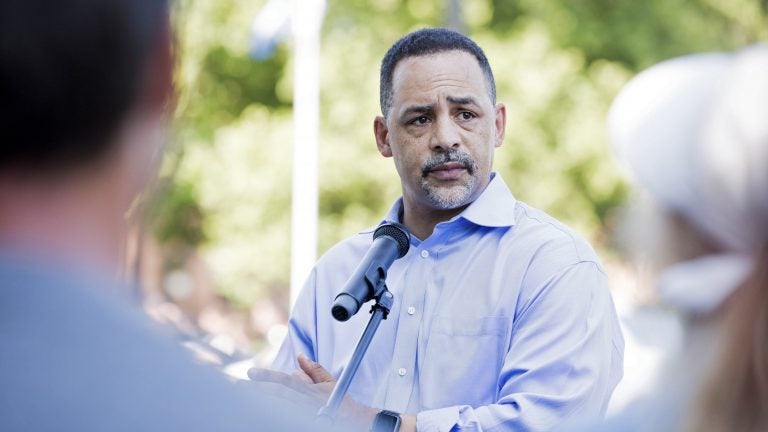Democratic legislators say fixing school funding is a moral imperative
The opportunity gaps in Pennsylvania between rich and poor, black and white, are among the highest in the nation.

Pennsylvania state Rep. Chris Rabb speaks at a rally in July 2018 (Rachel Wisniewski for WHYY)
Using words like “urgency,” and “moral imperative,” the state House Democratic Policy Committee, convened by State Rep. Christopher Rabb, met in Philadelphia this week to emphasize the need to overhaul the state’s system for funding its schools.
The legislators heard from several area school superintendents as well as advocates, including those behind a lawsuit charging that the current funding method violates the state constitutional guarantee that the state provide a “thorough and efficient” system of education.
The superintendents — from Pottstown, Upper Darby, Norristown and Lancaster — as well as Philadelphia Federation of Teachers president Jerry Jordan declared that their districts lack what they need to educate their students. Advocates presented evidence that the state’s funding system is racially discriminatory.
State funding for schools, in Pennsylvania and elsewhere, is meant to make up for differences in wealth among local municipalities. Each state does this differently and with varying enthusiasm and success. About half the states have been forced by the courts to make their funding system more fair and adequate to their students’ needs.
Pennsylvania, whose courts until now have declined to get involved, has among the largest inequities between its wealthier and lower income districts. While the nationwide average is for the state to pay about half of total education costs, Pennsylvania’s state share has dropped to about a third, meaning that a large burden falls on local municipalities, which fund their schools primarily through property taxes.
“This truly is a crisis,” said Superintendent Stephen Rodriguez of Pottstown, a onetime industrial center that now has a poverty rate over 20 percent. He and the other superintendents cited large class sizes, a lack of librarians and counselors, insufficient special education services, and the inability to fund needed positions like social workers.
Jordan pointed out that in all of the Philadelphia School District’s more than 200 schools, there are just seven certified librarians.
The forum took place in the auditorium of Emlen Elementary School, and for the beginning of the session, children sat in the audience holding signs that said “#end educational apartheid” and “fair funding now.”
Superintendent Christopher Dormer of Lancaster asked them to stand up. The inadequate and inequitable funding “is taking opportunities away from them,” he said. “We can’t lose sight of that.”
Almost all of Emlen’s students are African American. “This is real life, these are real kids,” said Superintendent Damaris Rau of Lancaster. “It is black and brown kids,” she said, who are hurt the most by the system.
The legislature adopted a new school funding formula in 2015 that distributes money based on a district’s enrollment, as well as other factors including poverty, and local tax effort.
But the formula, known as Act 35, is used only for a small percentage of the aid the state sends to districts. The bulk of the state’s $6 billion basic education subsidy is distributed based on past patterns, an accumulation of old formulas and decades of ad hoc decisions. This comes along with a guarantee that no district will lose aid from one year to the next — the so-called “hold harmless” clause.
As a result of these decisions, longstanding inequities are baked into the system. Due to hold harmless, districts that lost significant student population — most of which are largely white — didn’t lose funding. At the same time the enrollment and needs of other districts grew, but state aid didn’t keep up. Districts became more reliant on the property tax to fund schools.
“We are the fifth most underfunded district in the state but have the sixth highest tax burden,” said Pottstown’s Rodriguez.
David Mosenkis, a statistician affiliated with the faith-based advocacy group POWER, first showed in 2014 that Pennsylvania’s method for distributing state school aid had a discriminatory impact based on race.
At this meeting, Mosenkis said his new analysis shows that since the adoption of the formula, and the decision to apply it only to new aid instead of the whole pot, the funding inequities in Pennsylvania have only gotten worse.
The whitest districts get $2,200 per student more of basic education funding than the formula says they deserve, while those that are less white get $2,100 less than their fair share, Mosenkis has calculated. “We are choosing every year to perpetuate systemic racial bias,” he said.
By way of illustration, Mosenkis brought several transparent jars with him onstage, one filled with brown water and the other containing some clear water. Mosenkis poured a little clear water into the polluted water. “The clean water is helping a little, but the drinking water is just getting more polluted,” he said.
David Lapp of Research for Action said that it is preparing a report showing that Pennsylvania’s white students are in the top five of states when it comes to opportunity, including access to such resources as Advanced Placement courses, calculus and physics, dual enrollment with colleges, gifted and talented programs, and disciplinary policies that avoid suspension in favor of restorative justice. At the same time, the commonwealth’s black students are in the bottom five of states in terms of access to opportunity, he said.
“That’s the first time I’ve heard that statistic,” said State Rep. Mike Sturla, a Democrat from Lancaster County. “That takes away…that really starts to take it home.”
While he and other legislators said they understand the problem, they said solving it will not be easy. Sturla said some of his legislative colleagues think that fairness means that each district gets the same amount of state aid regardless of the need or poverty level. For many of them, he said, some of the school districts within their legislative districts would gain while others would lose funding if the formula were applied to all the aid, and they don’t want to face that problem. Some mid-state representatives have dozens of school districts among their constituency, each with its own demographic trends and local economic conditions.
Those legislators “are the toughest to convince,” Sturla said. “They don’t talk about this issue. They say their constituents don’t understand it.”
Rabb, a Philadelphia Democrat, has introduced legislation that would push the entire basic education allotment — more than $6 billion — through the formula. But he says that alone is not the answer. The problem, he said, is that the overall pie is not big enough.
While the distribution method is unfair, he said after the session, “the 800 pound gorilla in the room is that we need significantly more money. We are not getting significant revenues to support a 21st century educational system.”
Advocates echoed that position. “It is not a choice between equity and adequacy. Of course, we need a big enough pie to distribute so everyone has what they need,” said Mosenkis.
Michael Churchill of the Public Interest Law Center and Deborah Gordon Klehr of the Education Law Center said that simply doing what Rabb proposes will also lead to some injustices.
“I don’t think it is the right thing to do. It will hurt many poor districts,” said Churchill. The right thing to do, he said, is to grow the pot of education aid.
That is also a tough sell. Many legislators believe that spending more will not improve outcomes, feeling that school districts waste funds in ways that don’t boost student outcomes. They have balked at many of Gov. Wolf’s tax increase proposals, including on natural gas production.
“It’s a morally repugnant question, ‘Does money matter?’” said State Rep. Michael Zabel, a Democrat from Delaware County.
The superintendents who spoke said that they would welcome accountability for additional funds.
“Give us the money, and we’ll show you the results,” said Upper Darby Superintendent Daniel McGarry.
The fair funding lawsuit is scheduled to be heard in the summer of 2020, and any changes resulting from that could be many years away. Republican leaders who control the state House and Senate have fought the lawsuit, saying school funding is not an issue for courts to decide. Their attorneys have argued that the state meets its constitutional obligation solely by creating a system of education, no matter how unequal.
Rabb and State Rep. Joseph Hohenstein, a Democrat representing Philadelphia, strongly disagree.
“We can’t be dealing with incremental solutions,” Hohenstein said. “The urgency is what struck me. We can’t keep losing a generation of kids.”
WHYY is your source for fact-based, in-depth journalism and information. As a nonprofit organization, we rely on financial support from readers like you. Please give today.




